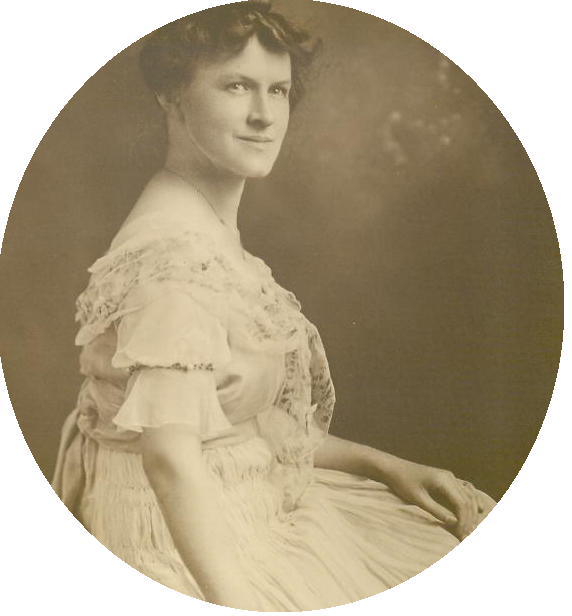


|
My dear friends: I have promised you a longer letter this time; and I will not fail you. Much has happened since my last brief epistle was penned. (Half of it pencilled, after I dropped my fountain pen, point downward). Just now we are stranded in Bryson City, N.C. with a broken axle. The trials and tribulations attending this trip that my sister and I are making from Kinzel Springs, Tenn., to Ashville, N.C. and return, would make quite a story in itself - so I'll save that for next time. Suffice to say that the nearest axle that will set us in motion again is in Asheville, seventy miles away. That fact, attended by financial embarrassment, is exciting enough to keep me awake this night; so I might as well 'improve the shining hour' - I mean the raining hour, for it is raining pitchforks here tonight. To go back to Marietta - or are you tired of hearing about Marietta? Just two years ago the state built a museum around the old Rufus Putnam home, that weather-beaten relic of pioneer days. This old home, built in 1796, is made of the wood taken from the original stockade, a kind of fort, built as protection against the Indians by the united efforts, to be used as the joint home of those first few families who came to settle a new country in 1788. The house, though unpainted, has bravely withstood the elements all these years. That is because it is so sturdily built of great, axe-hewn logs and veritable plank floors. To me the house seemed more romantic in its earlier days when I saw it in its bare simplicity, with the few authentic pieces of furniture and bric-a-brac that had shared the family life. Now the house is all "finished" inside, and "dolled up" with period furniture and trimmings. There are heavy walnut and cherry four-poster beds, one with a canopy; and marvelous quilts, made long ago. The child's room is especially charming, with its trundle bed and quaint doll cradle; fussy little frills here and there. The huge open fireplace (hearth, I should say) has the swinging crane, the original brass tea-kettle and heavy iron pots, a brass bed-warming pan, the heavy tongs, the bellows, and a big roasting spit nearby. In the "parlor" is a beautiful old organ, made in England in 1830. The whole museum is a reminder of the industry of our forefathers; of women who knit and spun and sewed by hand; of sturdy men who built homes in the wilderness, who fashioned tools out of raw materials at hand. In the basement is a good-sized canoe, carved out of a tree-trunk; a shovel made out of one piece of wood; wooden rakes, cheese-press; the village's first "fire-engine"; a genuine covered wagon; an all-wood wheel-barrow, etc., etc. There is too much to remember or relate. (It is now Saturday afternoon and I must boil down the news to follow, in order to mail this). I would like to tell you a great deal more about the museum - the costumes worn in the early 1800's, the Willow-ware china, beautiful silver, Lafayette's champagne chest, the Indian relics, the old books, and so many more things I can't begin to mention; but I am running a risk of boring you. We visited Mound Cemetery, where there is a huge, cone-shaped mound, the grave yard of pre-historic man. Many soldiers of the Revolution are buried in that beautiful cemetery. Marietta has its practical side, too. It makes the largest factory grind-stones in the country. It was with reluctance that we left the Elm city Sunday morning, and went on to Charleston, W. Va., passing up Parkersburg. My first night "under the stars" had given me such neuralgia or neuritis in the face I could hardly drive, and had to take frequent rests. We didn't reach the Capitol at Charleston until after five - just too late to be taken through by a guide. We went through the main halls of the central court - the main part. I can't tell you much about it except that the building is new, the old one having been burned down a few years ago. The present building was completed two years ago, at a cost of $8,000,000. It is built of beautiful white sandstone, with an elaborate dome, entirely covered with gold leaf. The building was designed by Cass Gilbert, the noted architect of New York, and is said to be the most beautiful capitol in the U.S. Perhaps only West Virginians think so. The landscaping, not yet done, will cost $250,000, if the architect is allowed to carry out his plans. There is a most interesting museum in the south wing. We took a fleeting glimpse early Monday morning. Faded, torn flags, old papers, valuable documents, all kinds of musketry, mementos of the zeal and sincerity of the people of the Confederacy. There are the mounted animals and birds native to West Virginia; the Indian relics, of course, etc. My chief education in Charleston was along the line of batteries, generators, and the goodness in human nature. My memories of Charleston are most pleasant; the most gallant policemen I have ever encountered, the most gracious garagemen, hotel clerk, and even colored porter, who, after giving real service said, "You don't owe me a thing." For service and honesty above the average I recommend the Armature Winding Co. of Charleston. Goodness, it's mail time - and I must say "good-bye." We are settling down to a few days rest now, and maybe I can write something worthwhile for next week. Cordially, Florence B. Taylor.
| |